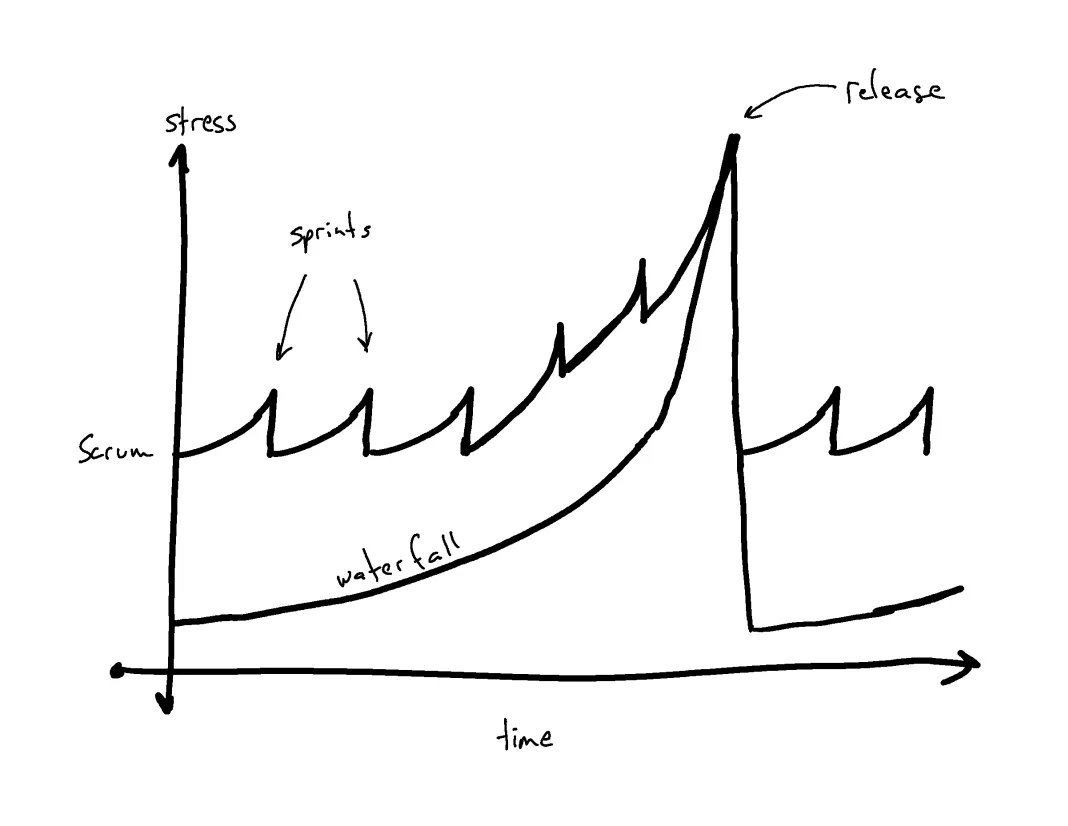Summary
While there are peaks in stress levels in the waterfall model of project management, they are often followed by a phase of low stress after a release. By shortening the cycle to two-week sprints, Scrum also shortens the low-energy period of work, which helps to reduce stress. At the same time, you still have high-stress phases not only at the end of sprints but also even more stress before major releases.
This heightens the overall stress level. Our bodies are pretty good at handling short periods of high stress, but prolonged periods of high stress are unhealthy.
Scrum sprints are also involuntary. Autonomy is one of the main psychological needs and is important for motivation (see Peopleware). But in Scrum, you cannot really decide what the structure of the sprint is.
Also, Scrum neglects key supporting activities of engineering prep work. You cannot just do the implementation work; a software project does not only involve implementation but also exploring new solutions, brainstorming, or learning new patterns.
Quotes
Reference: https://rethinkingsoftware.substack.com/p/why-scrum-is-stressing-you-out
- Sprints never stop
“Waterfall was structured around genuine deadlines and real-world events that demanded focused attention. You worked hard to get something working, then you were done. High pressure was followed by low pressure. Sprints, on the other hand, are fake deadlines, invented for the sake of a process.”
“While Waterfall causes higher spikes in stress, sprints impose a more constant, medium-level stress. The difference lies between higher short-term stress and medium, long-term stress. While no stress is entirely comfortable, our bodies are better equipped to handle short-term stress.”
- Sprints are involuntary
“If a development team were to sit down and decide to deliver code every two weeks, based on a process of their own design—one that made sense to them and suited their circumstances—that would be one thing. But sprints in a Scrum-like process don’t work that way. Every aspect of a sprint is prescribed: its duration, its meetings, its tasks, and even the roles of its participants. You might think that choosing your own process wouldn’t make much of a difference, but research tells a different story. Autonomy—the ability to direct one’s own work—plays a significant role in how work is experienced.”
- Sprints Neglect Key Supporting Activities
“Another stressful aspect of sprints in a Scrum-like environment is that they often leave you feeling unprepared for the next task. This happens because no time is set aside for proper engineering prep work.”
“If you are charged with getting a task done, what proportion of your time ought to be dedicated to actually doing the task? Not 100 percent. There ought to be some provision for brainstorming, investigating new methods, figuring out how to avoid doing some of the subtasks, reading, training, and just goofing off.
— Peopleware, Tom DeMarco and Timothy Lister”
